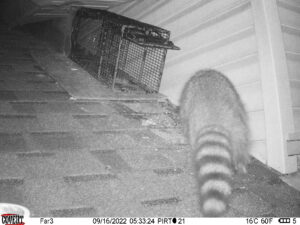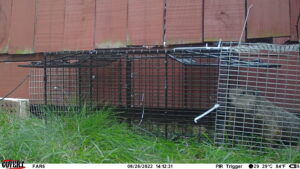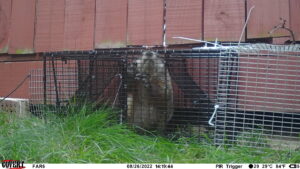Tip: Control Animal Movement
Successful groundhog trapping with a positive set requires controlling groundhog movement. The trap must cover the way in and out. All other avenues of travel (alternative exits/entrances) need blocked.
In this video, Ryan needed to block some areas. He used some junk plywood from another job. Blocking materials can be anything.

The same theme is on display in this next video.
Ryan knew where the groundhog’s main hole was. The mission was blocking all of the travel paths and getting the trap in place. An air conditioner dictated that a little creativity was needed to get the trap set and block off alternative routes. Blocking other possible paths can be accomplished with all sorts of material.
In this video, Ryan uses bricks, landscape timbers, and plywood found in the backyard he’s trapping to help control the groundhog movement. The take-away is that controlling the groundhog’s access in and out of the hole just takes some creativity. Check it out.

Positive Set Trapping for Groundhogs
Today’s post revisits the concept of a “Positive Set” and shows why it is often the preferred method for efficient nuisance animal removal.
As you saw in the above videos, no bait was used. Instead a double door trap was placed right where the groundhog had to walk through it. This is called a positive set. When the animal is there, it is the most efficient trapping method there is.
It doesn’t only work for groundhogs. Here are some pictures of the same concept.




The great majority of nuisance animals we deal with use very specific travel paths. These travel paths are often best defined where they are entering/exiting a den entrance.
Putting a trap on the travel path of a nuisance animal just makes sense. And, when you actually incorporate the trap into the travel path, you’ve just made a positive set.
What it Takes to Make A Positive Set
You’ve seen our examples, now it’s time to put the plan in action. Here’s what you need.
A clearly defined path of travel. Exits and entrance holes are great. Finding them around foundations isn’t too bad. Locating them on the roof presents certain challenges.
A trap that can be incorporated into the travel path. For this, we recommend double door traps for the bigger animals and repeater traps for squirrels. Most of our double door traps have spring loaded doors that fire when an animal brushes by wire in the middle of the trap.
Blocking material. In order to get the animal to go through the trap, it can’t have any other options. This blocking of other possible travel paths calls for creativity. The material can be anything. We use a lot of wire and purchase blocking aids that are sold by trap manufacturers.
When you put all these things together, you are certain to capture an animal that moves through that spot.
Animal Removal & Control | Stark, Summit, Portage County
For all of your nuisance animal removal needs in the Akron, Canton, Kent Ohio area, give us a call.
We have the tools, methods, and experience to solve your critter problem.

